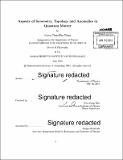| dc.contributor.advisor | Xiao-Gang Wen. | en_US |
| dc.contributor.author | Wang, Juven Chun-Fan | en_US |
| dc.contributor.other | Massachusetts Institute of Technology. Department of Physics. | en_US |
| dc.date.accessioned | 2015-10-14T15:03:14Z | |
| dc.date.available | 2015-10-14T15:03:14Z | |
| dc.date.copyright | 2015 | en_US |
| dc.date.issued | 2015 | en_US |
| dc.identifier.uri | http://hdl.handle.net/1721.1/99285 | |
| dc.description | Thesis: Ph. D., Massachusetts Institute of Technology, Department of Physics, 2015. | en_US |
| dc.description | Cataloged from PDF version of thesis. | en_US |
| dc.description | Includes bibliographical references (pages 223-230). | en_US |
| dc.description.abstract | To understand the new physics and richness of quantum many-body system phenomena is one of the stimuli driving the condensed matter community forward. Importantly, the new insights and solutions for condensed matter theory sometimes come from the developed and developing knowledge of high energy theory, mathematical and particle physics, which is also true the other way around: Condensed matter physics has been providing crucial hints and playgrounds for the fundamental laws of high energy physics. In this thesis, we explore the aspects of symmetry, topology and anomalies in quantum matter with entanglement from both condensed matter and high energy theory viewpoints. The focus of our research is on the gapped many-body quantum systems including symmetry-protected topological states (SPTs) and topologically ordered states (TOs). We first explore the ground state structures of SPTs and TOs: the former can be symmetry twisted and the latter has robust degeneracy. The Berry phases generated by transporting and overlapping ground state sectors potentially provide universal topological invariants that fully characterize the SPTs and TOs. This framework provides us the aspects of symmetry and topology. We establish a field theory representation of SPT invariants in any dimension to uncover group cohomology classification and beyond -- the former for SPTs with gapless boundary gauge anomalies, the latter for SPTs with mixed gauge-gravity anomalies. We study topological orders in 3+1 dimensions such as Dijkgraaf-Witten models, which support multi-string braiding statistics; the resulting patterns may be analyzed by the mathematical theory of knots and links. We explore the aspects of surface anomalies of bulk gapped states from the bulk-edge correspondence: The gauge anomalies of SPTs shed light on the construction of bosonic anomalies including Goldstone-Wilczek type, and also guide us to design a non-perturbative lattice model regularizing the low-energy chiral fermion/gauge theory towards the Standard Model while overcoming the Nielsen-Ninomiya fermion-doubling problem without relying on Ginsparg-Wilson fermions. We conclude by utilizing aspects of both quantum mechanical topology and spacetime topology to derive new formulas analogous to Verlinde's via geometric-topology surgery. This provides new insights for higher dimensional topological states of matter. | en_US |
| dc.description.statementofresponsibility | by Juven Chun-Fan Wang. | en_US |
| dc.format.extent | 230 pages | en_US |
| dc.language.iso | eng | en_US |
| dc.publisher | Massachusetts Institute of Technology | en_US |
| dc.rights | M.I.T. theses are protected by copyright. They may be viewed from this source for any purpose, but reproduction or distribution in any format is prohibited without written permission. See provided URL for inquiries about permission. | en_US |
| dc.rights.uri | http://dspace.mit.edu/handle/1721.1/7582 | en_US |
| dc.subject | Physics. | en_US |
| dc.title | Aspects of symmetry, topology and anomalies in quantum matter | en_US |
| dc.type | Thesis | en_US |
| dc.description.degree | Ph. D. | en_US |
| dc.contributor.department | Massachusetts Institute of Technology. Department of Physics | |
| dc.identifier.oclc | 922885130 | en_US |
